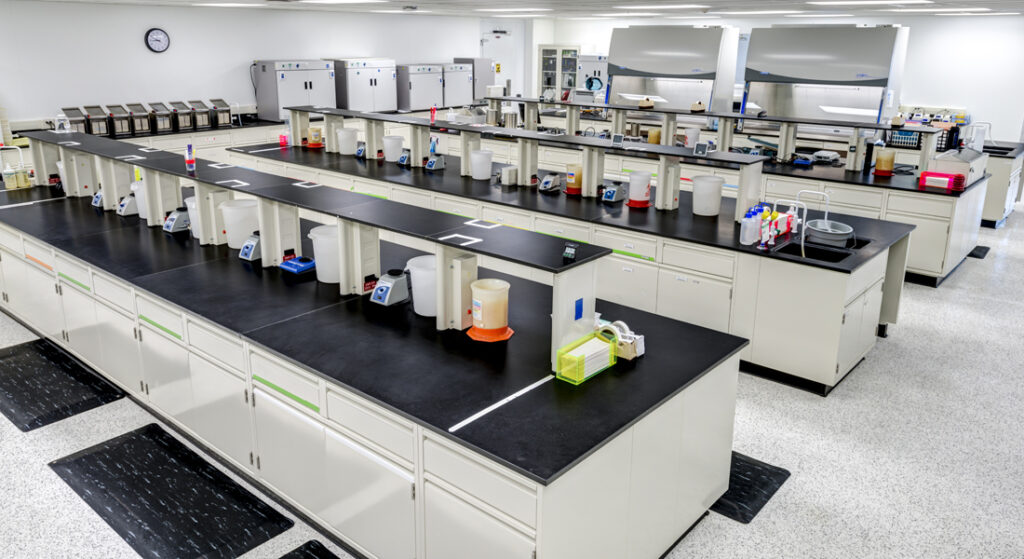Every space in your innovation center is important, whether it is a highly functional lab space or a welcoming and engaging lobby. The significance of laboratory space to research & development (R&D) efforts is undisputable; yet in many ways the spaces in between the principle work areas — like coffee stations, huddle spaces and elevator lobbies — can actually matter more when it comes to innovation.
Many times, these commonly overlooked or uninspired spots contain the potential to foster conversations and collaboration that are the spark of innovation. The humble coffee station is a great example of this.
As detailed in a case study cited in the Harvard Business Review, a pharmaceutical company wanted to increase sales. The company ran a study which proved that sales went up when employees spent more time engaging and interacting with each other.
As a result, they modified their coffee stations as well as their cafeteria. The result? Sales increased 20 percent after the changes were made. Like this company discovered, collaboration is essential to any business’ success, and the same holds true for a successful R&D center of tomorrow.
Let’s look at collaboration and six other critical elements that can improve the possibilities for innovation and provide positive stimulus for your organization.
1. Space to Collaborate
To date, most of the design emphasis for R&D centers has been centered on enabling employees to do focused individual work. Today, however, new ideas on collaboration, socialization, and even innovation are migrating from traditional corporate workplace design into the lab environment.
Companies are beginning to create work zones outside of the lab itself to accommodate different work modes, since regulations and the high cost of lab space can make it cost prohibitive to include these spaces in the lab. Yet there are multiple ways that companies can provide strategic locations to encourage interdisciplinary interaction and the exchange of ideas.
These can include social areas or connection points, such as open grouped seating, located at or around circulation points (e.g., corridors and communicating stairs), providing access to coffee and food throughout the building; and enabling virtual collaboration through technology.
2. Flexibility in How You Work
A company and a workplace that recognizes both the physical and mental needs of their employees is almost certain to get the best from them. In fact, researchers at Cornell University studied 300 small businesses and found that companies who granted employees the ability to work the way they want to work actually grew four times faster and had one third less turnover.
Whether they are scientists, lab techs, or business and marketing personnel, employees tend to be more effective when their work environment complements their personal work style, preferences and needs. Flexible workspaces allow R&D personnel to customize spaces the way that works best for them, stimulating creativity without losing sight of overall corporate culture.
Some ways that this can be implemented in a lab environment include quiet rooms (to help support individual, focused and or privacy needs), and stand-up meetings (which can be faster and more efficient than at a seated table).
3. Right-Size Room Size
Have you ever been in a room that was too small and then you had to sit uncomfortably close to the person next to you? Were you able to do your best, or were you distracted? Having the right size room can make all the difference in how well a meeting can run, and how well engaged the team members are in the activities at hand.
Traditional design has created meeting spaces designed for the largest capacity possible. If four people are in a room designed to hold 20, the space feels cavernous and off-putting. Instead, in today’s world with COVID-19, we are currently designing rooms to accommodate social distancing guidelines that then can be converted later to be the right size for the needs of the users.
This requires planning in phases, e.g., considering power and HVAC needs in the future, adding flexibility with furniture, and looking at ease of construction, if required, at a later date during occupancy.
4. Access to Daylight
Daylight can have an extraordinarily positive effect on productivity. However, labs have typically been positioned in the middle of buildings to take advantage of centralized mechanical systems, with offices located around the perimeter. Just like the shift occurring in the workplace sector, private offices are being moved to the center, with shared workspaces, such as labs, moving to the exterior to capitalize on lighting and environments.
5. Get Moving
In addition to accommodating the various modes of working, it is also important to consider movement. For the employee, the ability to move throughout the day contributes to productivity. Moving helps blood flow, which promotes clearer thinking.
Desks that allow employees to sit or stand, or even treadmill desks can help. In addition, consider implementing activity-centered options such as fitness centers or walking paths, where meetings can take place while moving.
6. Efficient Workflows
Improving workflow to reduce wasted motion through the office is another goal of many R&D re-designs, with replenishment of materials being a big part of that issue. While no one wants large amounts of expensive compounds sitting out in the lab, scientists do not want to constantly have to leave the lab to go to the supply closet.
7. The “Wow” Factor
Best practices should include creating a workplace that delivers function, “state of the art” work and display tools, and well-designed, interesting architectural features that unify and inspire employees and visitors alike. The “wow” factor of materials, equipment and other components can help with employee retention and enhance client perception of the company as a whole.
In addition to the “wow” factor, durable materials for R&D spaces should be selected to help the facility continue to be fresh and innovative for at least a decade or more. When designing an R&D center or other lab work environment, it is imperative to think ahead.
If your organization is like most, you’ve been thinking about making changes to your existing lab (or building a new one) for a long time. At some point, the “go” signal will be given and the rush will be on. Even when the need to renovate or build is urgent, make sure to take the time to:
- Truly understand what your business needs and how it can work best.
- Consider adopting ideas into your space that will help foster innovation.
- Create a change management strategy. This includes selecting champions for change within your organization who can help you roll out the re-design and gain acceptance down through the ranks.
- Incorporate agility into your facility so that it can be adapted as needs change in the future. Doing so will allow your lab design project to be mindful and flexible so that your building will support the future growth and ideas and what you need to do in the building today and beyond.
R&D ventures require many factors to coalesce for success to be achieved. Re-thinking the work setting, from labs to offices and all points in-between, and including the design ideas for collaboration, socialization and more, has the potential to increase innovation throughout your organization.
This article was created in collaboration with the sponsoring company and the Xtalks editorial team.








Join or login to leave a comment
JOIN LOGIN